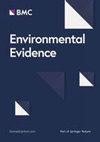Existing evidence on the use of environmental DNA as an operational method for studying rivers: a systematic map and thematic synthesis
IF 5.2
4区 环境科学与生态学
Q2 ENVIRONMENTAL SCIENCES
引用次数: 0
Abstract
Environmental DNA (eDNA) is the DNA that can be extracted from an environmental sample, enabling the monitoring of whole biological communities across a large number of samples, at a potentially lower cost, which can significantly benefit river conservation. A systematic mapping protocol was designed to investigate the use of eDNA in rivers, specifically in terms of research topics, geographic and taxonomic biases, as well as information gaps. Furthermore, the potential research opportunities of eDNA in rivers and possible paths to find this kind of information on available platforms are identified. A published systematic map protocol was applied, consisting of a search for published articles and gray literature in two bibliographic databases and one search engine. All search results were submitted to a 2-stage screening for relevance and pertinence in accordance with pre-defined eligibility criteria. Data extraction and codification regarding country of study, year, taxonomic group, sequencing platform, and type of technique employed resulted in a publicly available database. From 7372 studies initially obtained by the search, 545 met the inclusion criteria spanning a period from 2003 to 2022. The five countries with most studies are: USA (134), Japan (61), China (54), Brazil (29) and the UK (25). The most used fragments to analyze DNA are 16S and COI, whilst 26S and 23S are the least used. Only 84 (15%) of the studies reported hypervariable regions, among which the most used are V4 and V5. Regarding taxonomic groups, fishes are most often studied (176), followed by bacteria (138) and virus (52), while fungi is the least studied group (3). Concerning data availability, 229 (42%) studies provided access to sequencing data. This study presents a comprehensive analysis of the available evidence regarding the implementation of the eDNA methods in rivers. The findings indicate that since the year 2003, this approach has been applied to aquatic lotic systems, and their recent increase can be attributed to the development of Next-Generation-Sequencing technologies and their reduced costs. However, there is a bias towards high-income countries, particularly USA and Europe. Widespread use and applications of this approach at a global level would allow for the generation of a large amount of information that can be compared between countries to understand if responses of aquatic systems follow similar patterns worldwide.将环境 DNA 作为研究河流的操作方法的现有证据:系统图和专题综述
环境 DNA(eDNA)是从环境样本中提取的 DNA,能够以较低的成本监测大量样本中的整个生物群落,对河流保护大有裨益。为了调查 eDNA 在河流中的使用情况,特别是在研究课题、地理和分类偏差以及信息缺口方面,我们设计了一个系统的绘图协议。此外,还确定了河流中 eDNA 的潜在研究机会以及在现有平台上查找此类信息的可能途径。该研究采用了已发布的系统地图协议,包括在两个文献数据库和一个搜索引擎中搜索已发表的文章和灰色文献。根据预先确定的资格标准,对所有搜索结果的相关性和针对性进行了两阶段筛选。对研究的国家、年份、分类组别、测序平台和采用的技术类型进行数据提取和编码后,形成了一个可公开获取的数据库。在搜索初步获得的 7372 项研究中,有 545 项符合纳入标准,时间跨度为 2003 年至 2022 年。研究最多的五个国家是美国(134 项)、日本(61 项)、中国(54 项)、巴西(29 项)和英国(25 项)。分析 DNA 使用最多的片段是 16S 和 COI,而 26S 和 23S 使用最少。只有 84 项(15%)研究报告了超变异区域,其中使用最多的是 V4 和 V5。在分类群体方面,鱼类研究最多(176 项),其次是细菌(138 项)和病毒(52 项),而真菌是研究最少的群体(3 项)。在数据可用性方面,229 项研究(42%)提供了测序数据。本研究全面分析了有关在河流中使用 eDNA 方法的现有证据。研究结果表明,自 2003 年以来,这种方法已被应用于水生地层系统,近期应用的增加可归因于下一代测序技术的发展及其成本的降低。然而,这种方法偏向于高收入国家,尤其是美国和欧洲。在全球范围内广泛使用和应用这种方法,可以产生大量的信息,在各国之间进行比较,以了解水生系统的反应是否在全球范围内遵循类似的模式。
本文章由计算机程序翻译,如有差异,请以英文原文为准。
求助全文
约1分钟内获得全文
求助全文
来源期刊

Environmental Evidence
Environmental Science-Management, Monitoring, Policy and Law
CiteScore
6.10
自引率
18.20%
发文量
36
审稿时长
17 weeks
期刊介绍:
Environmental Evidence is the journal of the Collaboration for Environmental Evidence (CEE). The Journal facilitates rapid publication of evidence syntheses, in the form of Systematic Reviews and Maps conducted to CEE Guidelines and Standards. We focus on the effectiveness of environmental management interventions and the impact of human activities on the environment. Our scope covers all forms of environmental management and human impacts and therefore spans the natural and social sciences. Subjects include water security, agriculture, food security, forestry, fisheries, natural resource management, biodiversity conservation, climate change, ecosystem services, pollution, invasive species, environment and human wellbeing, sustainable energy use, soil management, environmental legislation, environmental education.
 求助内容:
求助内容: 应助结果提醒方式:
应助结果提醒方式:


